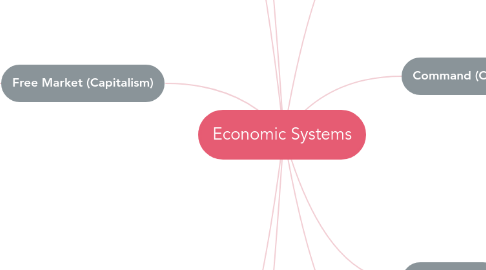
1. Pros
1.1. Equal distribution of control in a mixed economy.
1.2. Private firms have more efficiency and private enterprises have the freedom to thrive on his or her own.
1.3. Mixed economies can be a safe haven from poverty.
1.4. Government has a defined role as a referee and a higher chance for the government to implement good policies.
2. Types of Economic Systems
2.1. Market or capitalism, command or communism, socialism which has characteristics of both command and market economics, and mixed economy which there is a mix of capitalism and socialism with government control.
2.1.1. Capitalism is a free market approach to economics. It is characterized by the right to own private property, the right to own a business, and keep the profits, the right to freedom of competition, and the right to freedom of choice (Nickels, McHugh, & McHugh, 2016).
2.1.1.1. The United States is a good example of this economic system.
2.1.2. Command also known as communist economies are characterized by government control of all resources (Nickels, McHugh, & McHugh, 2016).
2.1.2.1. North Korea is a good example of this economic system.
2.1.3. Socialism has characteristics of a command economy in that the government controls most resources. Entrepreneurs have the ability to own and run small businesses which is a characteristics of capitalism (Nickels, McHugh, & McHugh, 2016).
2.1.3.1. China is a good example of this economic system.
2.1.4. Mixed economies exist where some allocation of resources was made by the market and some by the government. Some countries do not have a name for this system.
2.1.4.1. Iceland is a good example of this economic system.
3. Free Market (Capitalism)
3.1. Pros
3.1.1. People are willing to take more risks than he or she might have otherwise.
3.1.2. Little government influence economic system.
3.1.3. Decisions on the price products and services determined by supply and demand.
3.1.4. Goods and services are produced efficiently and consumers are willing to pay higher prices for the things he or she wants most.
3.2. Cons
3.2.1. The government does not protect the free market and it does regulate enough, which situations such as government bailouts occur.
3.2.2. Children, elderly, people with mental or physical disabilities may be at competitive disadvantage.
3.2.3. Economy produces unbalanced results, which some can become very rich others poor, homeless, and etc.
4. Socialism
4.1. Pros
4.1.1. Socialism has the opportunity for free education through college along with free health care and free child care.
4.1.2. Socialism uses money from taxes of the wealthier people in the form of taxes and redistributes it to the poorer people through government programs.
4.1.3. Works get longer vacations, work shorter hours per week, and have generous benefits from sick leave and other benefits for employees, than those in countries where free market capitalism prevails (Nickels, McHugh, & McHugh, 2016).
4.2. Cons
4.2.1. Socialism may create more equality than capitalism, but it steals the businesspeople' s incentives.
4.2.2. Doctors, lawyers, and business owners who earn a high income pay a very high tax rate.
4.2.3. Many leave socialist countries for capitalist counties with lower taxes, such as the United States (Nickels, McHugh, & McHugh, 2016).
4.2.4. Socialism results in fewer inventions and less innovation, because individuals who think of new ideas do not receive the credit and reward as he or should would in a capitalist system.
5. Mixed Economy
5.1. Cons
5.1.1. Mixed economies can sometimes be faced with the government pushing the limit to far.
5.1.2. Corporate size is limited in the mix economy.
5.1.3. It can be very challenging too locate balance.
5.1.4. Excessive government intervention can occur with mixed economies.
6. The Importance of an Economic System
6.1. Economic systems determine how the society will employ resources to produce goods and services, then distribute among individuals and competing groups (Nickels, McHugh, & McHugh, 2016).
7. Command (Communism)
7.1. Pros
7.1.1. Command economies quickly mobilize economic resources planned out on a large scale and can meet social goals, execute expansive projects, and create industrial projects.
7.1.2. Command economies can transform societies to conform around the governments vision.
7.2. Cons
7.2.1. Businesses are very limited in a command economy.
7.2.2. No personal freedom, rather that be where he or she wants to live, religion, and personal choices.
7.2.3. Produce to much of on thing and not enough of another, plans are generated ahead of time and do not accurately anticipate consumer demand products and services (Nickels, McHugh, & McHugh, 2016).
